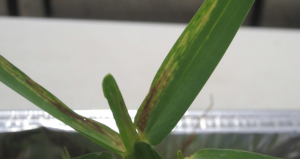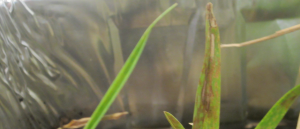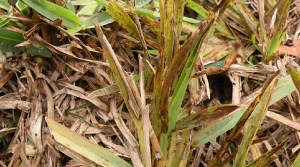At the end of 2017, the Plant Diagnostic Clinic at UF/TREC discovered that some turfgrass samples from Miami-Dade and Monroe County tested positive for Lethal Viral Necrosis (LVN). Early symptoms include a mosaic pattern on the leaf that becomes necrotic (turns brown and dies prematurely) over time. According to Dr. Phil Harmon, UF/IFAS Plant Diagnostic Center, the symptoms present blotchy and streaky patterns of yellow and green color. In fact, turfgrass tends to have broken yellow streaks running between the veins on an otherwise green blade. The symptoms and dieback typically start in the fall months of September and October and continues through the winter into spring. Some lawns may appear to recover in the spring. Unfortunately, lawns that appear to recover eventually die over a period of 1-3 years. Infected lawns may completely dieback.




Spreads and Prevention
The most common way of spreading the disease is mechanical. Lawn equipment such as lawn mowers and string trimmers containing lawn clippings infected with LVN in the sap can spread the diseases. For that reason, mow the property that you suspect has the disease last! Also, good sanitation practices are very important to prevent this disease from becoming more widespread. Cleaning, or at a minimum, drying and blowing off equipment before leaving one site to travel to another site, will help prevent disease spread. In areas where the disease is known to occur, potentially contaminated equipment parts should be cleaned and sprayed down using the following:
- 1 part PineSol type disinfectant with 3 parts water
- Potassium peroxymonosulfate & Sodium Chloride (Virkon S) mixed at a 2 percent solution·
- Quaternary ammonia products ·
- Physan 20 ·
- Lysol ·
- 1 part household bleach with 9 parts water. Caution: bleach rusts steel.
Sampling
In order to obtain reliable lab results the turf sample must be taken correctly. Bad samples mean bad results.
Take a cup cutter-sized plug from diseased, but still living St. Augustinegrass. A coffee can with both top and bottom removed could be used or just a shovel to cut a few sq. inches of sod from weak areas. Remove excess soil from the plug, but not wash or add water. Take a picture of the lawn from where the sample was taken, that’s good info too! Record the variety of St. Augustinegrass that was planted there, age of planting, street address, and any other information relevant information like previous application of fertilizer or pesticides.
Lawn Replacement
St. Augustine ‘Floratam’ turfgrass has exhibited the most severe symptoms. ‘Floratam’ lawns that have died due to LVN are susceptible to dying again if replaced with ‘Floratam’. The current recommendation is to replace lawns that have died as a result of LVN with a more resistant turfgrass. ‘Palmetto’ and ‘Citrablue’ are more resistant. Zoysiagrass is not known to be a host of LVN. Other grasses such as bermudagrass, seashore paspalum and bahiagrass have been reported with LVN infections but not as heavy as St. Augustine.

Management
Unfortunately, there are no known pesticides or other products that homeowners or landscape professionals can apply to lawns to prevent the development, spread or cure the disease. The severity varies from lawn to lawn and the symptoms could be minor yellowing to death. Good sanitation and sod replacement with resistant varieties or replacing lawn areas with alternative plant material or hardscape elements are the only landscape options available.
Reporting and Diagnosis off LVN
Tracking the spread of LVN in Florida is very important to determine the means of transmission and any changes in resistance. If you suspect that your lawn is affected by LVN submit a sample to your local UF/IFAS Extension office, to the UF/IFAS Plant Diagnostic Center, http://plantpath.ifas.ufl.edu/extension/plant-diagnostic-center/
Future Workshop
The UF/IFAS Miami- Dade Extension in partnership with Helena Inc. are going to present a workshop about LVN on February 8th from 11:30 AM to 12:30 PM at Tropical Park, Mary Abreu Community Center. For registration go to https://www.eventbrite.com/e/sugarcane-mosaic-virus-in-saint-augustinegrass-tickets-42057689682
Resources
- Mosaic Diseases of St. Augustinegrass Caused by SCMV, http://edis.ifas.ufl.edu/pp313
- Sugarcane Mosaic Virus on St. Augustinegrass, http://discover.pbcgov.org/coextension/horticulture/pdf/commercial/Sugarcane%20Mosaic%20Virus.pdf
- Palm Beach County Extension, http://discover.pbcgov.org/coextension/horticulture/Pages/Sugarcane-Gallery.aspx
- UF/IFAS Plant Diagnostic Center, http://plantpath.ifas.ufl.edu/extension/plant-diagnostic-center/
- Sugarcane Mosaic Virus of Saint Augustinegrass, https://blogs.ifas.ufl.edu/hillsboroughco/2017/11/01/sugarcane-mosaic-virus-st-augustinegrass/
 0
0
